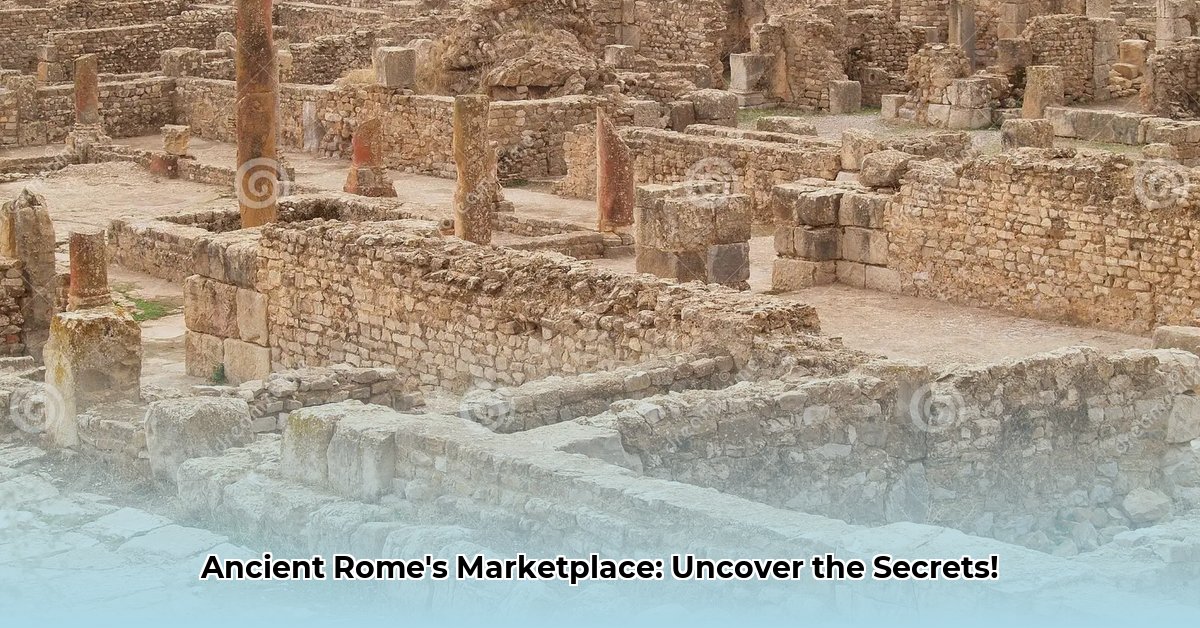The ancient Roman marketplace was far more than a simple venue; it was the vibrant, pulsating heart of Roman civilization, a complex ecosystem where economics, society, and culture converged. Roman commerce, a major sector of its economy from the Republic through the Imperial period, fueled the empire’s prosperity, shaped daily life, and left an indelible mark on how we conduct business in the modern world. This intricate economic system, often overshadowed by military exploits and linguistic influence, was, in fact, the very backbone supporting the legions and the spread of Latin. The longevity of the Roman Empire was intrinsically linked to its sophisticated commercial trade. You can explore Roman markets for more information.
The Fabric of Roman Commerce: Society, Marketplaces, and Financial Systems
Roman society, though theoretically restricting senators and their sons from trade, saw members of the equestrian order deeply involved in business despite their upper-class values that emphasized military and leisure. Plebeians and freedmen commonly held shop or manned stalls, while vast numbers of slaves performed the majority of manual labor, and were themselves valuable commodities in commercial transactions. This societal stratification gave Roman commerce a distinct flavor, marked by the realities of runaway slaves and occasional uprisings.
The heart of daily Roman economic life resided in its diverse marketplaces. The iconic Roman Forum, while serving as the civic and religious nucleus, also harbored a thriving commercial life. As Rome grew, specialized markets emerged: the Forum Boarium for cattle, the Forum Holitorium for vegetables, and the Forum Piscarium for fish. The Forum Cuppedinis specialized in delicacies and general goods, reflecting the city’s increasing demand for variety. These structured specializations demonstrate a remarkable Roman genius for organizing vital commercial activities to serve a burgeoning urban population.
Beyond the open forums, smaller shops lined city streets, often occupying the lower floors of houses. In early Roman history, craftsmen typically sold their own creations. However, as Rome expanded, a class of “middlemen” or wholesalers emerged, facilitating broader distribution. Wealthy Roman citizens frequently dispatched their slaves to conduct shopping, while poorer citizens focused on acquiring basic necessities like bread, porridge, and vegetables such.
The intricate and extensive accounting of Roman trade relied on counting boards and the Roman abacus, which, using Roman numerals, was ideally suited for handling Roman currency and measures. Financial professionals played crucial roles: negotiatores acted as bankers, lending money on interest and engaging in bulk or wholesale trade of staples. Argentarii functioned as agents in auctions, managed individual deposits, cashed checks (prescriptiones), and served as moneychangers. Sometimes classified as a subset of negotiatores, at other times seen as a distinct group, argentarii occasionally performed duties similar to mensarii, who were public bankers appointed by the state, known for their strict tabulae (books) that held legal proof in courts. Mercatores, typically plebeians or freedmen, operated stalls in open-air markets, covered shops, and even near military camps, selling food and clothing to soldiers and purchasing booty.
One of the most impressive testaments to Roman commercial ambition was Trajan’s Market, constructed between 107 AD and 110 AD. Often regarded as the world’s first multi-story shopping mall, this complex featured over 150 shops (tabernae) across six levels, offering an astonishing array of goods sourced from every corner of the vast Roman Empire. Visitors navigated its intricate passages, discovering everything from essential dry goods, flowers, and vegetables to rare exotic spices, fine wines, and olive oils. The Via Biberatica, a street within the complex, housed numerous beverage shops, highlighting the diverse commercial offerings. This impressive structure was not merely an architectural marvel but also a powerful symbol of the empire’s sophisticated and dynamic economy, illustrating Roman engineering prowess and their commitment to facilitating commerce.
Global Reach and Strategic Trade Routes: Fueling Imperial Ambition
Roman commerce was, by no means, confined to city limits. Extensive maritime trade routes served as the crucial arteries connecting Rome to distant lands across the Mediterranean Sea and far into the Indian Ocean. The cost of sea transportation was sixty times lower than land transport, making it indispensable for bulky, low-value commodities like grain, construction materials, and basic foodstuffs. Strategic ports such as Civitavecchia, Ostia, Portus, Leptis Magna, and Caesarea Maritima formed vital gateways, facilitating commerce with distant markets.
The trade across the Indian Ocean blossomed remarkably in the 1st and 2nd centuries AD. Roman sailors utilized the monsoon winds to navigate from Red Sea ports like Berenice, Leukos Limen, and Myos Hormos to ports such as Muziris and Nelkynda on India’s Malabar Coast. Major trading partners in southern India included the Tamil dynasties of the Pandyas, Cholas, and Cheras. This exchange brought a wealth of luxury items and essential raw materials into Rome. Detailed descriptions of these ports and traded items can be found in the Greek work, Periplus of the Erythraean Sea. Archaeological discoveries, such as Roman artifacts at Arikamedu and pottery remains at Naduvirapattu in India, provide compelling evidence of this extensive trade, which largely involved the import of spices (pepper, cardamom, cloves, cinnamon), sandalwood, gems (pearls, rubies, diamonds, emeralds), and ivory in exchange for Roman silver and gold.
Beyond India, Roman merchants ventured as far as Southeast Asia. Ptolemy’s Geography mapped out the land bordering the Magnus Sinus (Gulf of Thailand and South China Sea) as Sinae. The port city of “Cattigara,” possibly the ancient settlement at Oc Eo, Vietnam, yielded Roman artifacts from the Antonine period, including medallions from the reigns of Antoninus Pius and Marcus Aurelius. Chinese texts like the Weilüe and Book of Later Han record an embassy from “Daqin” (Roman Empire) by “An Dun” (Antoninus Pius or Marcus Aurelius) in 166 AD, though likely involving Roman merchants rather than official diplomats. While Roman coins found in China are fewer compared to India, indicating that India was likely the primary point for acquiring Chinese silk, the spice trade remained more economically significant for Rome.
Regional specialization was a hallmark of the Roman economy. Provinces like Egypt and North Africa became indispensable suppliers of grain, a critical commodity for feeding the imperial capital. Meanwhile, regions such as Italy, Hispania, and Greece distinguished themselves through specialized production of wine and olive oil. Other notable traded goods, often leaving archaeological traces like amphorae, included garum (fermented fish sauce), black pepper, and various nuts and fruits, even exotic items like coconuts.
The maintenance of peace, particularly during the Pax Romana (Roman Peace), was a major factor in the expansion of trade. This stability allowed settlements, especially smaller ones, to be located in economically rational positions rather than solely defensive hilltop sites, which were preferred before and after the Roman Empire due to piracy. Roman roads, though primarily conceived for military logistics, dramatically enhanced the efficiency of both trade and transportation across the empire. Navigable rivers were extensively used, and some canals were dug, though their archaeological traces are less prominent than roads, leading to their underestimation.
Catalysts of Growth: Technology, Currency, and Regulation
The Roman aptitude for technological innovation proved to be a pivotal driver of their enduring economic success. Advancements such as watermills and sophisticated potter’s wheels boosted manufacturing output. While Roman seagoing commercial ships showed no significant advances over Greek ships, the lead sheeting of hulls for protection became more common. The robust network of Roman roads, despite being designed more for feet and hooves than wheels, significantly streamlined the transport of goods, laying the groundwork for efficient logistics. Innovation was also evident in measurement tools, like carefully calibrated scales.
A fairly standard, stable, and abundant currency, particularly the denarius, up to circa 200 AD, did much to facilitate trade. While Egypt and some provincial cities issued their own coins, the overall stability of the Roman monetary system was crucial. The Roman system of measurement, built on Greek and Egyptian influences, was accurate and well-documented. Distances were systematically measured and inscribed on stone by government agents. A central standard amphora, the amphora capitolina, was even kept in the temple of Jupiter on the Capitoline Hill to ensure consistent comparison.
To foster fair practices and maintain order within their bustling marketplaces, the Roman government actively implemented and enforced trade regulations. Laws were meticulously crafted to safeguard the interests of both sellers and buyers, addressing critical aspects such as product quality, precise sizing, and fair pricing mechanisms. Dedicated market regulators vigilantly monitored compliance with these statutes, imposing heavy penalties on vendors who violated them; repeat offenders faced harsher consequences. A notable example, the Lex Aelia Sentia of 4 AD, explicitly aimed at preventing guilds of merchants from setting prices and encouraging healthy competition, demonstrating an early understanding of the vital role of competitive enterprise in a flourishing economy. The annona system, designed to guarantee a stable and adequate grain supply for Rome’s massive populace, effectively balanced state control with elements of market freedom. This foresight in economic governance offers valuable parallels for modern regulatory bodies aiming to prevent market distortions.
Despite legal restrictions (e.g., Lex Claudia of 218 BC, restricting senators from owning ships over 300 amphorae capacity), Roman senators found ways to engage in trade. While direct, small-scale trade was often deemed dishonorable, large-scale commerce, especially if it led to land investment, was surprisingly seen as legitimate. Senators often utilized free and enslaved agents as a loophole, diversifying their income. Cato, himself involved in trade through a freedman proxy, exemplified this indirect participation, highlighting that while land ownership was safer, commercial ventures offered significant wealth acquisition opportunities, albeit with risks that could threaten a senator’s financial standing.
The Inevitable Decline and Enduring Legacy
Despite its considerable initial successes, Roman commerce experienced a noticeable decline during the 3rd century CE. This period of contraction resulted from a complex interplay of both internal and external pressures. Factors such as pervasive political instability, a marked decrease in trade activity, escalating tax burdens, and significant currency devaluation all contributed. The concurrent rise of large, self-sufficient aristocratic estates in the countryside further diminished the need for centralized market activities and diverted capital from productive commercial enterprises. Persistent warfare on the empire’s borders and reduced mining productivity, particularly in Spain, exacerbated the economic deterioration. Some historical analyses even suggest that climate change may have played a contributing role in agricultural decline, thereby impacting the integrity and volume of critical trade networks. The reliance on slaves for industrial output also limited technological advancement, as the poor majority could not afford sophisticated products.
The profound impact of Roman commerce continues to resonate powerfully in our contemporary world. The fundamental principles and regulatory frameworks meticulously established by the Roman government continue to influence modern trade laws, robust consumer protection measures, and sophisticated banking systems. Concepts such as standardized currency, essential infrastructure development, and efficient logistical practices can all be traced directly back to the ingenuity of Roman commercial operations.
Here’s a glimpse into how the ancient Roman marketplace profoundly influenced modern practices:
| Roman Practice | Modern Equivalent |
|---|---|
| Standardized weights and measures | Global standards (e.g., metric system, ISO) |
| Market inspectors and regulations | Consumer protection agencies, trade commissions |
| Public forums for trade and exchange | Stock exchanges, online marketplaces, commodity pits |
| Road networks facilitating commerce | Modern highway systems, global logistics networks |
| Banking and financial services (argentarii) | Commercial banks, investment firms |
The Roman experience offers invaluable lessons for contemporary policymakers and sophisticated business strategists. Their annona system for food security provides insight into balancing government intervention with free-market principles. The reliance on maritime transport for efficient supply chains still guides modern infrastructure development in ports and logistics. Moreover, studying ancient Roman trade regulations offers profound insights into managing complex international commerce and ensuring equitable, fair trade practices in today’s global economy. The long-term, transformative impact of extensive global connectivity on diverse societies, as demonstrated by Roman trade, provides a crucial historical lens through which to examine modern issues like resource distribution and management.
| Insights | Relevance Today |
|---|---|
| Infrastructure | Contemporary infrastructure projects can draw inspiration from Roman investments in highly strategic roads and ports to significantly enhance global trade efficiency and supply chain resilience. |
| Trade Regulations | A meticulous study of ancient Roman trade regulations offers profound insights into managing complex international commerce and ensuring equitable, fair trade practices in today’s global economy. |
| Globalization | Roman trade vividly illustrates the long-term, transformative impact of extensive global connectivity on diverse societies, providing a crucial historical lens through which to examine modern issues like resource distribution and management. |
In conclusion, ancient Roman commerce fostered extensive economic growth and promoted widespread cultural exchange, laying the groundwork for standardized global trade practices through robust infrastructure and a stable currency. However, it also faced significant challenges from piracy and market fluctuations, and ultimately succumbed to a complex interplay of internal and external factors. Despite its decline, the system left an indelible imprint on the trajectory of the empire and on the very structure of our modern economy. Its enduring legacy serves as a potent reminder that the foundational elements of our sophisticated contemporary economic systems possess deep roots stretching back into classical antiquity.
| Roman Commerce Strengths | Roman Commerce Weaknesses |
|---|---|
| Facilitated extensive economic growth | Piracy caused significant and frequent disruptions |
| Promoted widespread cultural exchange | Market fluctuations impacted economic stability |
| Paved the way for standardized trade practices | Inability to prevent long-term decline due to systemic issues |
| Developed sophisticated financial institutions | Limited technological advancement due to slave labor |
| Ensured essential goods supply (annona) | Susceptible to political instability and heavy taxation |










